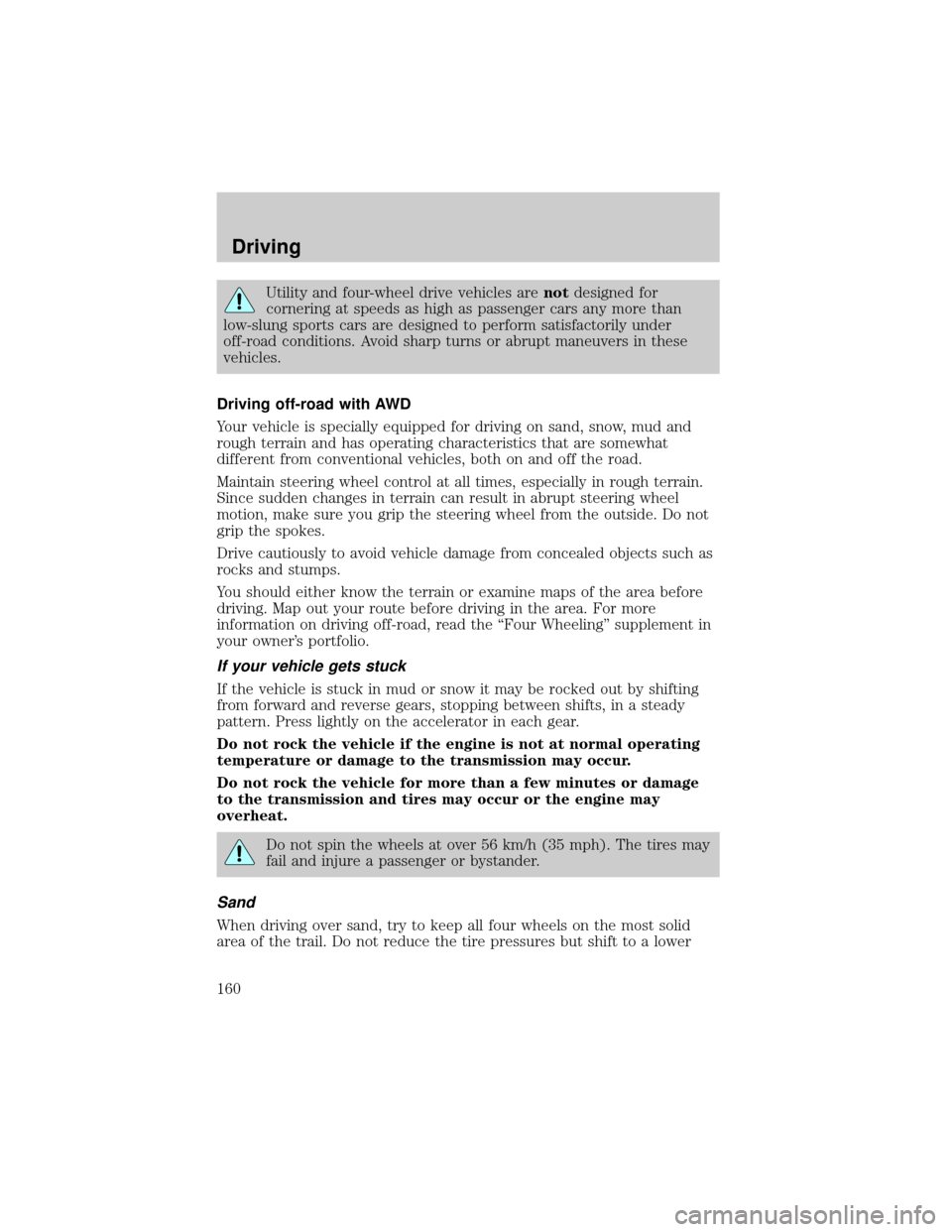four wheel drive Mercury Mountaineer 2000 s User Guide
[x] Cancel search | Manufacturer: MERCURY, Model Year: 2000, Model line: Mountaineer, Model: Mercury Mountaineer 2000Pages: 264, PDF Size: 2.29 MB
Page 159 of 264

When climbing a steep hill, start in a lower gear rather than downshifting
to a lower gear from a higher gear once the ascent has started. This
reduces the strain on the engine.
When descending a steep hill, avoid sudden braking. Shift to a lower gear
when added engine braking is desired.
When speed control is on and you are driving uphill, your vehicle speed
may drop considerably, especially if you are carrying a heavy load.
If vehicle speed drops more than 16 km/h (10 mph), the speed control
will cancel automatically. Resume speed with accelerator pedal.
If speed control cancels after climbing the hill, reset speed by pressing
and holding the SET ACCEL button (to resume speeds over 50 km/h (30
mph).
Automatic transmissions may shift frequently while driving up steep
grades. Eliminate frequent shifting by shifting out of
(Overdrive) into
D (Drive).
Driving on snow and ice
A 4WD vehicle has advantages over 2WD vehicles in snow and ice but
can skid like any other vehicle.
Avoid sudden applications of power and quick changes of direction on
snow and ice. Apply the accelerator slowly and steadily when starting
from a full stop.
When braking, apply the brakes as you normally would. In order to allow
the anti-lock brake system (ABS) to operate properly, keep steady
pressure on the brake pedal.
Allow more stopping distance and drive slower than usual. Consider
using one of the lower gears.
ALL WHEEL DRIVE (AWD) SYSTEM (IF EQUIPPED)
(5.0L ENGINES ONLY)
Your vehicle is equipped with a full-time All Wheel Drive (AWD) transfer
case. Power is supplied to all four wheels all the time with no need to
shift between two-wheel drive and four-wheel drive.
For the lubricant specification and refill capacity of the AWD transfer
case refer toCapacities and specificationschapter.
Driving
159
Page 160 of 264

Utility and four-wheel drive vehicles arenotdesigned for
cornering at speeds as high as passenger cars any more than
low-slung sports cars are designed to perform satisfactorily under
off-road conditions. Avoid sharp turns or abrupt maneuvers in these
vehicles.
Driving off-road with AWD
Your vehicle is specially equipped for driving on sand, snow, mud and
rough terrain and has operating characteristics that are somewhat
different from conventional vehicles, both on and off the road.
Maintain steering wheel control at all times, especially in rough terrain.
Since sudden changes in terrain can result in abrupt steering wheel
motion, make sure you grip the steering wheel from the outside. Do not
grip the spokes.
Drive cautiously to avoid vehicle damage from concealed objects such as
rocks and stumps.
You should either know the terrain or examine maps of the area before
driving. Map out your route before driving in the area. For more
information on driving off-road, read the ªFour Wheelingº supplement in
your owner's portfolio.
If your vehicle gets stuck
If the vehicle is stuck in mud or snow it may be rocked out by shifting
from forward and reverse gears, stopping between shifts, in a steady
pattern. Press lightly on the accelerator in each gear.
Do not rock the vehicle if the engine is not at normal operating
temperature or damage to the transmission may occur.
Do not rock the vehicle for more than a few minutes or damage
to the transmission and tires may occur or the engine may
overheat.
Do not spin the wheels at over 56 km/h (35 mph). The tires may
fail and injure a passenger or bystander.
Sand
When driving over sand, try to keep all four wheels on the most solid
area of the trail. Do not reduce the tire pressures but shift to a lower
Driving
160
Page 224 of 264
![Mercury Mountaineer 2000 s User Guide Conditions
²Heavily loading a vehicle or towing a trailer may reduce fuel economy
at any speed.
²Carrying unnecessary weight may reduce fuel economy (approximately
0.4 km/L [1 mpg] is lost for every Mercury Mountaineer 2000 s User Guide Conditions
²Heavily loading a vehicle or towing a trailer may reduce fuel economy
at any speed.
²Carrying unnecessary weight may reduce fuel economy (approximately
0.4 km/L [1 mpg] is lost for every](/img/33/10997/w960_10997-223.png)
Conditions
²Heavily loading a vehicle or towing a trailer may reduce fuel economy
at any speed.
²Carrying unnecessary weight may reduce fuel economy (approximately
0.4 km/L [1 mpg] is lost for every 180 kg [400 lb] of weight carried).
²Adding certain accessories to your vehicle (for example bug
deflectors, rollbars/light bars, running boards, ski/luggage racks) may
reduce fuel economy.
²Using fuel blended with alcohol may lower fuel economy.
²Fuel economy may decrease with lower temperatures during the first
12±16 km (8±10 miles) of driving.
²Driving on flat terrain offers improved fuel economy as compared to
driving on hilly terrain.
²Transmissions give their best fuel economy when operated in the top
cruise gear and with steady pressure on the gas pedal.
²Four-wheel-drive operation (if equipped) is less fuel efficient than
two-wheel-drive operation.
²Close windows for high speed driving.
EPA window sticker
Every new vehicle should have the EPA window sticker. Contact your
dealer if the window sticker is not supplied with your vehicle. The EPA
window sticker should be your guide for the fuel economy comparisons
with other vehicles.
It is important to note the box in the lower left corner of the window
sticker. These numbers represent the Range of L/100 km (MPG)
expected on the vehicle under optimum conditions. Your fuel economy
may vary depending upon the method of operation and conditions.
EMISSION CONTROL SYSTEM
Your vehicle is equipped with various emission control components and a
catalytic converter which will enable your vehicle to comply with
applicable exhaust emission standards. To make sure that the catalytic
converter and other emission control components continue to work
properly:
²Use only the specified fuel listed.
²Avoid running out of fuel.
Maintenance and care
224
Page 260 of 264

Foglamps .....................................21
Four-Wheel
Drive vehicles ..................11,12,154
control trac ........................33,154
description .......................155,156
driving off road ................157,160
electronic shift ..........................33
preparing to
drive your vehicle ...................147
Fuel ............................................217
calculating fuel economy ..18,221
cap ...........................................220
capacity ...................................237
choosing the right fuel ...........219
comparisons with EPA fuel
economy estimates .................224
detergent in fuel .....................220
filling your vehicle
with fuel ....................217,220,221
filter, specifications .........221,237
fuel pump shut-off switch .....172
gauge .........................................16
improving fuel economy ........221
octane rating ....................219,242
quality ......................................219
running out of fuel .................220
safety information relating to
automotive fuels .....................217
Fuses ...................................174,175
Garage door opener ...............84,88
Gas cap (see Fuel cap) ............220
Gas mileage
(see Fuel economy) .................221
Gauges .........................................14
battery voltage gauge ...............16
engine coolant
temperature gauge ...................14
engine oil pressure gauge ........16
fuel gauge ..................................16
odometer ...................................15
speedometer .............................14
tachometer ................................15trip odometer ............................15
GAWR
(Gross Axle Weight Rating) .....162
calculating ...............................165
definition .................................162
driving with a heavy load ......162
location ....................................162
GVWR (Gross
Vehicle Weight Rating) .............162
calculating ........................162,165
definition .................................162
driving with a heavy load ......162
location ....................................162
Hazard flashers .........................172
Head restraints .........................112
Headlamps ...................................21
aiming ......................................231
autolamp system .......................93
bulb specifications ..................230
daytime running lights .............21
flash to pass ..............................22
high beam ............................11,21
replacing bulbs .......................227
turning on and off ....................21
warning chime ..........................13
Heating ........................................22
heating and air
conditioning system .................22
HomeLink universal
transceiver (see
Garage door opener) ...88,89,90,91
Hood ..........................................193
Ignition .......................................242
positions of the ignition ...........76
Infant seats
(see Safety seats) .....................135
Inspection/maintenance
(I/M) testing ..............................225
Instrument panel
cleaning ...................................235
cluster ...................................8,235
Index
260